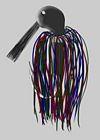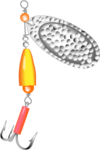Fishing lure
| fishing |
|---|
| lures |
| plug |
| little cleo |
| mormyshka |
| spinnerbait |
| spin fishing |
| sabiki |
| jig |
| spoon |
| spoonplug |
| surface lure |
| topwater lure |
| zara spook |
| heddon |
|
|
| plastic lures |
| artificial flies |
| tackle |
| recreational |
In recreational fishing, a lure is an object that is attached to the end of the fishing line and designed to resemble and move like prey. The purpose of the lure is to use movement, vibrations, and color to attract fish and induce them to bite the hook. Lures are equipped with one or more single, double, or treble hooks that are used to hook fish when they attack the lure.
Lures are usually used with a fishing rod and fishing reel outfit. When a lure is used for casting, it is continually cast out and retrieved.
Lure fishing can be challenging, exciting, and fun. While fish are naturally attracted to live bait, in lure fishing an angler has to control the movement of the lure to attract fish. Anglers must select the right lure, cast accurately, and retrieve at the right speed while considering water and weather conditions, species, fish response, time of the day, and other factors.
Lures that remain discarded can harm the environment and fish that inhabit it. In recent years, some manufacturers have developed lures made of biodegradable materials, and these environmentally friendly lures are gradually gaining more attention.
History
Fishing lures have been around since antiquity and were first made out of bone and bronze. The Chinese and Egyptians used fishing rods, hooks, and lines as early as 2,000 B.C.E. The first hooks were made out bronze and were strong and thin. The Chinese were the first to make fishing line, spun from fine silk. The modern fishing lure was made commercially in the United States in the early 1900s by the firm of Heddon and Pflueger in Michigan. Before this time most fishing lures were made by individual craftsman. Commercial-made lures were based on the same ideas used by individual craftsmen but on a larger scale.[1]
Methods
The fishing lure is tied to fishing line which is connected to a fishing reel and rod. Fishermen reel in the fishing line, sweep the fishing rod, jig, or let out line out the back of a moving boat ("trolling") to manipulate the motion of a lure. Other techniques that involve artificial flies, commonly called flies by fly fishermen, include letting the fly float on the surface, slowly submerge, or float underwater.
Types
There are many types of fishing lures that simulate a variety of movements and species.
jig
A jig consists of a metal sinker with a hook molded into it and usually covered by a soft body to attract fish. Jigs are made to move with a jerky, vertical motion, as opposed to spinnerbaits which move through the water horizontally. The jig is very versatile and can be used in both salt water as well as fresh water.
Surface lure
A surface lure is a fishing lure designed to waddle, pop, lock, drop, pulse, twitch or fizz across the surface of the water as it is retrieved, and in doing so imitate surface prey for fish such as mice, lizards, frogs, cicadas, moths and small injured fish.
A typical surface lure has a solid body made out of wood or plastic, carries one or two treble hooks, and has an eyelet at the front of the lure body to attach the fishing line.
- Waddlers get their action from a scooped metal dish attached to the front of the lure body.
- Poppers get their action from a cupped face carved or molded into the front of the lure body.
- Fizzers get their action both from the fisherman manipulating the lure with the fishing rod and from one or more blades attached to the lure body that spin when the lure is pulled and create a fizzing noise said to imitate the buzzing wings of a drowning insect.
Sizeable fish can create a sudden, noisy and spectacular explosion when they take a surface lure, usually giving the fisherman a fright in the process. Catching fish with surface lures is therefore considered a fairly exciting form of fishing.
Spoon lures
A spoon lure is, in sport fishing, an oblong, concave metal piece resembling a spoon. The spoon lure is mainly used to attract fish by reflecting light and moving randomly.
The spoon lure was invented by Julio T. Buel in about 1848. The design of the spoon lure is simple; an oblong, concave metal piece with a shiny chrome or paint finish, and a single or treble hook on the end.
While the basic principle of design has stayed the same over the years, its use has changed somewhat. Fishermen use the regular casting spoon (which is heavier) by casting past a specific area and retrieving the lure through it. Fishermen that use a trolling motor use spoons made with thinner material. While using the trolling motor on the boat, a fisherman could cover a wider body of water and increase their chances for a successful day. Using split shots, or other forms of weights, the fisherman could easily zero in his fishing lures' depth, depending on the speed involved. Also, spoons come in various colors and materials; for example, a silver plated spoon gives it a vibrant look.
Plugs
Plugs are a popular type of hard-bodied fishing lure. They are widely known by a number of other names depending on the country and region. Such names include crankbait, wobbler, minnow, shallow-diver and deep-diver. The term minnow is usually used for long, slender, lures that imitate baitfish, while the term plug is usually used for shorter, deeper-bodied lures which imitate deeper-bodied fish, frogs and other prey. Shallow-diver and deep-diver refer to the diving capabilities of the lure, which depends on the size of the lip and lure buoyancy.
Artificial flies
In general, artificial flies are used in fly fishing. Artificial flies may be made to represent all manner of potential freshwater and saltwater fish prey, including aquatic and terrestrial insects, crustaceans, worms, baitfish, vegetation, flesh, spawn, small reptiles, amphibians, mammals and birds, etc. Artificial flies were originally constructed from various furs, feathers, threads and hooks. Today there are literally dozens of different types of natural and synthetic materials used to construct artificial flies.[2] In the early years of fly fishing through the mid-twentieth century, effective artificial fly patterns were said to be killing flies because of their ability to put fish in the creel for the fly fisher. By the mid-nineteenth century, there were thousands of artificial fly patterns. Today, the number of distinct patterns is probably incalculable.
Soft plastic lures
Soft plastic lures are made out of plastic or rubber and are made to resemble worms, lizards, bait fish, squid, or any other kind of fish bait. Some are scented to attract more fish.
Spinnerbait
These fishing lures can be made out of wood, plastic, rubber, metal and cork. They can have many moving parts and also no moving parts. They can be retrieved fast or slow. Some of the lures can be used by themselves or with another lure.
Daisy chain
A daisy chain is a "chain" of plastic lures, however they do not have hooks - their main purpose is to merely attract a school of fish closer to the lures with hooks.
Typically, the main line of the daisy chain is clear monofilament line with crimped on droppers that connect the lure to the main line. The last lure can be rigged with a hook or unrigged. The unrigged versions are used as teasers while the hooked versions are connected to a rod and reel. The lures used on a daisy chain are made from cedar plugs, plastic squids, jets, and other soft and/or hard plastic lures.
In some countries (e.g. New Zealand, Australia) daisy chains can sometimes refer to a rig which is used to catch baitfish in a similar arrangement to a 'flasher rig' or a 'sabiki rig'; a series of hooks with a small piece of colorful material/feather/plastic attached to each hook.
See also
- Fishing
- Fishing boat
- Fishing line
- Fishing reel
- Fishing rod
- Fly fishing
Notes
- ↑ History of the fishing lure Retrieved July 9, 2008.
- ↑ Jacqueline Wakeford, Flytying: Tools and Materials (New York, NY: Lyons & Burford, 1992, ISBN 9781558211704).
Reference
- Becker, A. C. Lure Fishing. South Brunswick: A.S. Barnes, 1970. ISBN 0498074293
- Creative Publishing International. Fishing with Artificial Lures. The freshwater angler. Minnetonka, Minn: Creative Pub. International, 2000. ISBN 0865731101
- Eubanks, Calvin W. "Fishing Lure." The Journal of the Acoustical Society of America. 118, no. 4 (2005): 2107.
- Prokop, F. B. Lure Encyclopedia. Croydon South, Vic: Australian Fishing Network, 2005. ISBN 1865130761
- Sternberg, Dick. Fishing with Artificial Lures. The Hunting & fishing library. Minnetonka, Minn: C. DeCosse, 1985. ISBN 0865730091
- Wakeford, Jacqueline. Flytying: Tools and Materials. New York, NY: Lyons & Burford, 1992. ISBN 978-1558211834
External links
All links retrieved April 12, 2017.
- Antique Fishing Lure Galleries Old Fishing Lure
- Fishing lure description and usage of lures
| ||||||||||||||||||||||||||||||||||||||||||||||||||||||||
Credits
New World Encyclopedia writers and editors rewrote and completed the Wikipedia article in accordance with New World Encyclopedia standards. This article abides by terms of the Creative Commons CC-by-sa 3.0 License (CC-by-sa), which may be used and disseminated with proper attribution. Credit is due under the terms of this license that can reference both the New World Encyclopedia contributors and the selfless volunteer contributors of the Wikimedia Foundation. To cite this article click here for a list of acceptable citing formats.The history of earlier contributions by wikipedians is accessible to researchers here:
- Fishing_lure history
- Surface_lure history
- Jigging history
- Spoon_lure history
- Plug_(fishing) history
- Artificial_fly history
- Bass_worms history
The history of this article since it was imported to New World Encyclopedia:
Note: Some restrictions may apply to use of individual images which are separately licensed.





